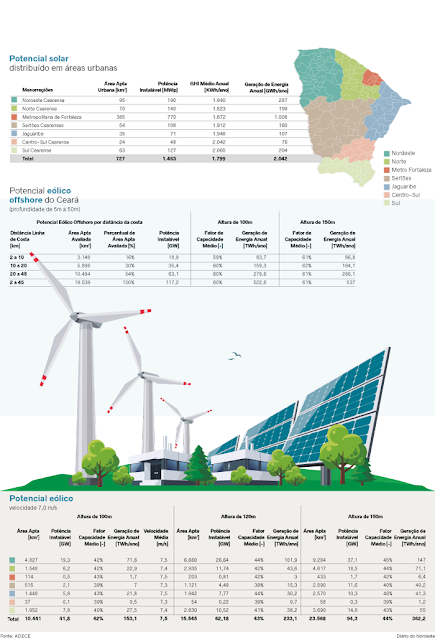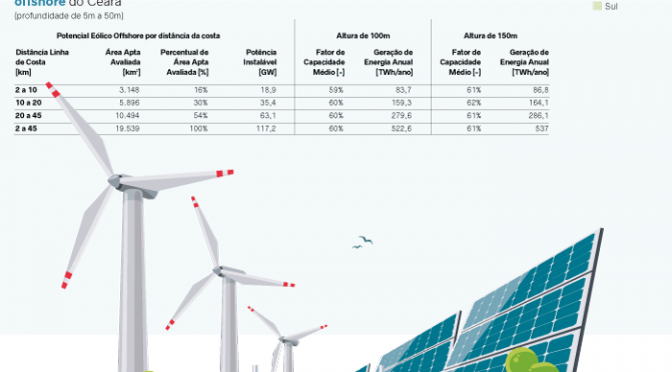According to the Atlas of solar and wind power potential of Ceará, the state could generate 94.3 GW, including wind energy, solar thermal and photovoltaic. Pioneer in stimulating wind turbines generation in Brazil, Ceará is about to launch its first hybrid solar and wind energy atlas. The study brings an integrated analysis of resources and generation potential of the state that covers areas of the coast and the interior of Ceará. The new atlas is a demand of the Renewable Energy Sector Chamber of the Development Agency of Ceará (Adece) and will be a starting point to attract new investments to the state.

“The
studies are ready, we are finalizing the compilation of data and
information technology (IT) tools, which will help investors to access
information. With the atlas, we can show where we have the best winds
and the best solar radiation conditions. Even with notes related to
environmental issues,” explains Adece president Eduardo Neves.
The
new atlas distinguishes Ceará from other states when it comes to peak
hours for wind farm generation with wind turbines, with greater
generation potential at the end of the afternoon and at dusk. “This is
our differential. The wind power of Ceará has more value than that of
other states. Our peak generation is at the moment of greatest demand,
while in neighboring states it is more at dawn,” says Adão Linhares,
Executive Secretary of Energy and Telecommunications of the Secretary of
State Infrastructure (Seinfra).
Currently, Ceará has 79 wind farm
projects in operation (2 GW), five wind farm projects not under
construction (115 MW) and 83 wind farm projects registered with the
National Electric Energy Agency (ANEEL), for a total of ~ 2.2 GW. Solar
energy in the state has four projects in operation (137 MW), 14 under
construction (390 MW), 110 solar power projects for a total of 3.7 GW
and 1,722 generation units distributed for a total of 36.6 MW.
The
survey presented by the atlas also reveals the possibility of building
offshore wind power plants in an area of ??10,000 square kilometers,
where the depth reaches 20 meters. If we consider the regions of up to
50 meters, the area reaches 19,000 square kilometers. “Ceará is
privileged not only for the winds, but for its shallow continental
shelf,” says CS Renováveis ??president Jurandir Picanço. Differentials
in offshore wind power generation compared to offshore wind farms
include wind speed and constancy at different times of the day.
“Technically
we are showing even conservative numbers. We can combine wind energy
and solar generation, and still have offshore with a near viability
(parks on land),” says Linhares. “It was a surprise the size of our
coast, and it shows that we are prepared to generate wind power at sea.
The
atlas also presents degraded areas of the state, which cannot be used
for agriculture, but can be used for the generation of photovoltaic and
concentrating solar thermal. Regions such as Inhamuns and Middle
Jaguaribe, for example, in addition to high levels of solar radiation,
offer low-cost land for the viability of new projects.
The new wind
and solar Atlas of Ceará is a public access document for professionals
in the renewable energy sector, which will provide technical information
on wind and solar resources in the state of Ceará. The objective of
this project is to facilitate the identification of areas with good
potential for the generation of energy from renewable energies, as well
as dimension the wind and solar potential by region of the state, thus
increasing the attractiveness of the state of Ceará for investments in
the area.
Ceará’s photovoltaic solar potential, estimated at 643
gigawatts (GW), is sufficient to supply Brazil’s current electricity
demand by more than double, according to the Ceará Solar and Wind
Potential Atlas, which will be presented on Monday, December 16 in the
Federation of Industries of Ceará (Fiec). According to the document, the
potential for wind power generation in the state, in turn, is 94.3
gigawatts.
The
Atlas notes that using only 7% of the territorial area of Ceará, the
potential for generating hybrid energy, with wind and solar power
generation, would be 137 GW, enough to supply approximately half of the
electricity demanded in the country. According
to the document, the wind source has an average capacity factor
(investment efficiency) of 44%, higher than Brazil, whose index is
42.5%, and the world average, which is 25%.
For
offshore wind power generation, Atlas points out that the generation
potential in Ceará is 117 GW, with a capacity factor of 62% and at low
depth. In Europe, where there are the largest number of parks on the high seas, the capacity factor is 37%.
http://atlas.adece.ce.gov.br/User?ReturnUrl=%2F


